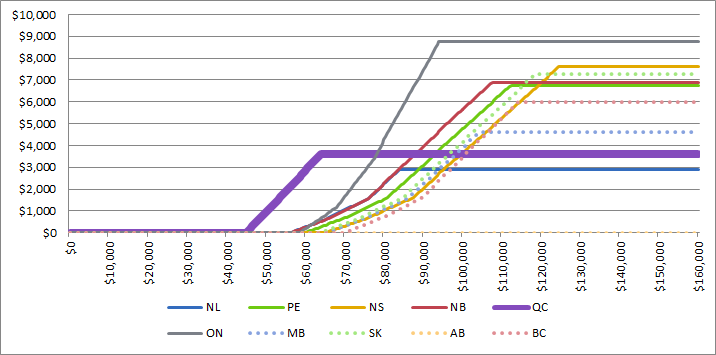As I noted last week , the Government of Quebec is about to receive an unanticipated windfall in the form of an $80-$100M/yr “alternative payment” from the Government of Canada when the new Canada Student Grant system comes into effect. What should it do with the money?
An easy reaction from the Finance people would probably be “stick it into general revenues”. The student aid system has got a lot more expensive in Quebec over the last few years. Between 2008-9 and 2013-4, Quebec’s expenditures on student grants rose by 40% after inflation ($563 M vs $405M, in 2015 dollars) which for a province which has been trying very hard to deliver balanced budgets is pretty impressive. So there will likely be some pressure to swallow the cash just say “hey, this money is for our recent upswing in spending, it’s just…late”. And of course there’s not a thing the feds could do about that if they wanted to. That’s how alternative payments work: they are “in respect of” student aid, not “for” student aid.
But let’s assume for the moment that the province wishes to use some or all of that money for student aid: where should it spend? Traditionally, students have usually pushed for reductions in the loan cut-off. In Quebec, the first few dollars awarded to a student are loan, up to a ceiling: after that, everything is grant. The ceiling differs by level of study and somewhat annoyingly is expressed as a monthly limit, but assuming an 8-month school year (yes, CEGEP years are closer to 9-months but stick with me here), the loan cut-off is $1776 for CEGEP students, $2464 for university students, and $3272 for graduate students. Above that it’s all grant. So the simplest change you can make is simply to lower that cut-off, and turn loans into grants.
But let me suggest that’s not the best way to spend the money. Instead, Quebec should do something less sexy, but more effective: change its parental contribution rules. Though Quebec has a reputation for being more accessible than other provinces because of low tuition-fees and relatively generous grants (for those deemed to have need), there is a category of students in Quebec who are actually much worse off than elsewhere because of more stringent contribution rules.
The following graph shows expected parental contributions by province and level of family income.
Figure 1. Expected Parental Contributions Towards Tuition Fees by Family Income* and Province
*Assumes a family of 4, both parents working, one making 10k more than the other.
Below $45,000, all provinces are the same – parents are not expected to contribute in any province. Above about $100,000 Quebec is better than any other province because tuition is lower – parental contributions effectively cap out because tuition is low (they may still get asked to pay for cost of living, but this is pretty similar everywhere. But look at the space $45,000 and $70,000 in family income: there, parents are asked to considerably more – or, to put it another way, students from families in this area receive less in student assistance than their peers elsewhere in the country.
When you hear complaints about student aid in Quebec, this is mostly what it’s about: middle income kids who can’t get loans, let alone grants. If Quebec used its new money to soften its parental contribution requirements (that is, basically shift its curve rightwards by $25,000 or so), it would allow substantially more students into the system and give a break to families in the $45-70,000 annual income bracket. And politically, who wouldn’t want to help this group?
Des idées pour vous mettre une puce a l’oreille…


 Tweet this post
Tweet this post
